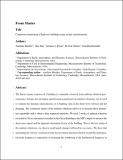| dc.contributor.author | Büyüköztürk, Oral | |
| dc.contributor.author | Mordret, Aurelien | |
| dc.contributor.author | Sun, Hao | |
| dc.contributor.author | Toksoz, M. Nafi | |
| dc.contributor.author | Buyukozturk, Oral | |
| dc.contributor.author | Prieto Gomez, German A. | |
| dc.date.accessioned | 2018-07-31T13:46:21Z | |
| dc.date.available | 2018-07-31T13:46:21Z | |
| dc.date.issued | 2017-12 | |
| dc.date.submitted | 2016-09 | |
| dc.identifier.issn | 0037-1106 | |
| dc.identifier.issn | 1943-3573 | |
| dc.identifier.uri | http://hdl.handle.net/1721.1/117212 | |
| dc.description.abstract | The linear seismic response of a building is commonly extracted from ambient vibration measurements. Seismic deconvolution interferometry performed on ambient vibrations can be used to estimate the dynamic characteristics of a building, such as its shear-wave velocity and its damping. The continuous nature of the ambient vibrations allows us to measure these parameters repeatedly and to observe their temporal variations. We used 2 weeks of ambient vibrations, recorded by 36 accelerometers that were installed in the Green Building at the Massachusetts Institute of Technology campus, to monitor the shear wavespeed and the apparent attenuation factor of the building. Because of the low strain of the ambient vibrations, we observed small speed changes followed by recoveries. We showed that measuring the velocity variations for the deconvolution functions, filtered around the fundamental-mode frequency, is equivalent to measuring the wandering of the fundamental frequency in the raw ambient vibration data. By comparing these results with local weather parameters, we showed that the air humidity is the dominating factor in the velocity variations of the waves in the Green Building, as well as the main force behind the wandering of the fundamental mode. The one-day periodic variations are affected by both the temperature and the humidity. The apparent attenuation, measured as the exponential decay of the fundamental-mode waveforms, is strongly biased due to the amplitude of the raw vibrations and shows a more complex behavior with respect to the weather measurements. We have also detected normal-mode nonlinear interaction for the Green Building, likely due to heterogeneity or anisotropy of its structure. We found that the temporal behavior of the frequency singlets may be used for monitoring. | en_US |
| dc.description.sponsorship | Royal Dutch-Shell Group (through MIT Energy Initiative) | en_US |
| dc.description.sponsorship | National Science Foundation (U. S.) (Grant Grant EAR-1415907) | en_US |
| dc.publisher | Seismological Society of America (SSA) | en_US |
| dc.relation.isversionof | http://dx.doi.org/10.1785/0120160282 | en_US |
| dc.rights | Creative Commons Attribution-Noncommercial-Share Alike | en_US |
| dc.rights.uri | http://creativecommons.org/licenses/by-nc-sa/4.0/ | en_US |
| dc.source | MIT Web Domain | en_US |
| dc.title | Continuous Monitoring of High‐Rise Buildings Using Seismic Interferometry | en_US |
| dc.type | Article | en_US |
| dc.identifier.citation | Mordret, Aurélien, Hao Sun, German A. Prieto, M. Nafi Toksöz, and Oral Büyüköztürk. “Continuous Monitoring of High‐Rise Buildings Using Seismic Interferometry.” Bulletin of the Seismological Society of America 107, no. 6 (September 26, 2017): 2759–2773. | en_US |
| dc.contributor.department | Massachusetts Institute of Technology. Department of Civil and Environmental Engineering | en_US |
| dc.contributor.department | Massachusetts Institute of Technology. Department of Earth, Atmospheric, and Planetary Sciences | en_US |
| dc.contributor.mitauthor | Mordret, Aurelien | |
| dc.contributor.mitauthor | Sun, Hao | |
| dc.contributor.mitauthor | Prieto Gomez, German | |
| dc.contributor.mitauthor | Toksoz, M. Nafi | |
| dc.contributor.mitauthor | Buyukozturk, Oral | |
| dc.relation.journal | Bulletin of the Seismological Society of America | en_US |
| dc.eprint.version | Author's final manuscript | en_US |
| dc.type.uri | http://purl.org/eprint/type/JournalArticle | en_US |
| eprint.status | http://purl.org/eprint/status/PeerReviewed | en_US |
| dc.date.updated | 2018-07-30T13:41:13Z | |
| dspace.orderedauthors | Mordret, Aurélien; Sun, Hao; Prieto, German A.; Toksöz, M. Nafi; Büyüköztürk, Oral | en_US |
| dspace.embargo.terms | N | en_US |
| dc.identifier.orcid | https://orcid.org/0000-0002-7998-5417 | |
| dc.identifier.orcid | https://orcid.org/0000-0002-5145-3259 | |
| dc.identifier.orcid | https://orcid.org/0000-0002-4851-3089 | |
| dc.identifier.orcid | https://orcid.org/0000-0002-7712-7478 | |
| mit.license | OPEN_ACCESS_POLICY | en_US |
